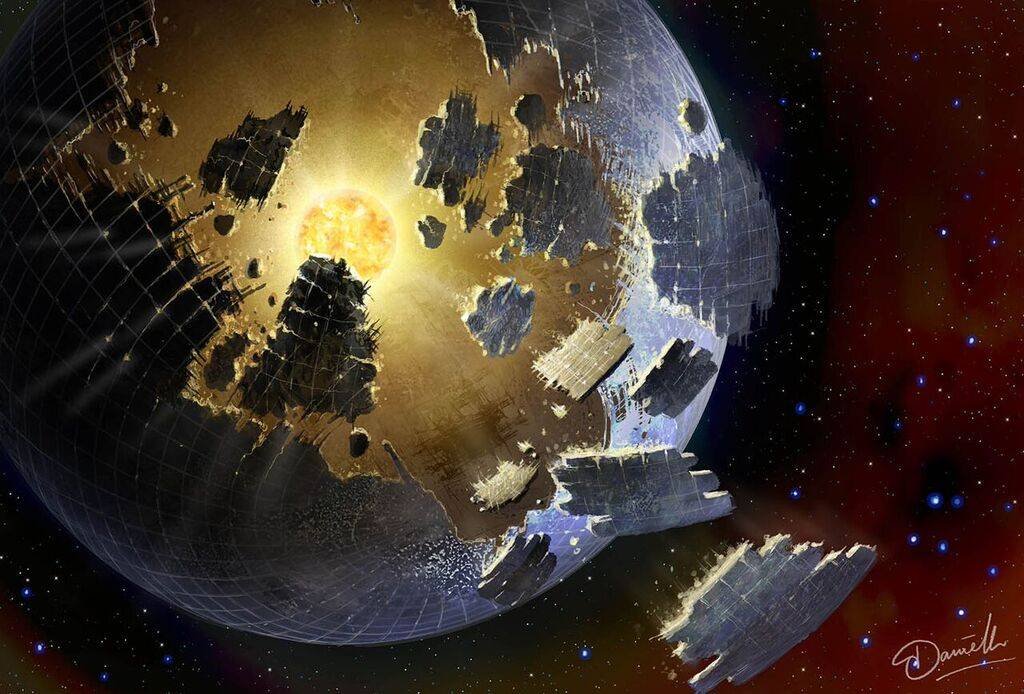Astronomers scanning distant star systems for signs of alien technology say they have found 60 candidates, including seven M-dwarf stars giving off unexpectedly high infrared heat signatures, which may be surrounded by orbiting extraterrestrial power plants known as Dyson Spheres (DSs).
First proposed by theoretical physicist Freeman Dyson back in 1960, confirmation of these aptly named devices would not only represent the first verifiable signs of life beyond Earth but would likely indicate a species that is more technologically advanced than humans since constructing a Dyson Sphere is still well beyond our current capabilities.
The team behind the tantalizing findings says that more follow-up analysis of the data is planned. However, their initial readings appear to be consistent with the presence of alien technology orbiting at least seven of these stars.
How to Spot Alien Technology Like a Dyson Sphere
Since humanity’s most powerful telescopes cannot image objects orbiting distant stars directly, researchers Matías Suazo at Uppsala University in Sweden and Gaby Contardo at the International School for Advanced Studies in Italy knew they would have to analyze light spectrum data emitted by millions of stars across the galaxy to search for signs of alien technology. In the case of Dyson Spheres, the team would need to look for an ‘unnatural’ imbalance between the visible light and the infrared light emitted by a distant star.
That’s because, as proposed by Dyson, the more technologically advanced a species becomes, the more energy it needs. If they become advanced enough, a species could, in theory, surround an entire star with a “sphere” designed to capture all of its emitted energy. The Debrief previously covered the science fiction origins and viability of Dyson Spheres in 2021.
A fully completed Dyson Sphere would be almost impossible to detect from such a long way away since all of its visible light would be captured by the sphere. However, either an incomplete sphere or a swarm of satellites known as a partial Dyson Sphere or a Dyson Swarm would still allow some of the visible light through for Earth’s telescopes to capture. At the same time, the sphere would radiate an excess of heat energy in the infrared spectrum as it captures the star’s radiated energy and then releases it into space.
Suazo and Contrado proposed that if the ratio between visible light and infrared light coming off of any particular star is just right, it would represent compelling evidence for the presence of a Dyson Sphere.
Analysis of Existing Data Finds Seven Tantalizing Candidates
In their published study, which appears in the Monthly Notices of the Royal Astronomical Society, the researchers note that previous efforts dating back to the 1980s and as recently as 2021 have looked for this same type of light signatures coming from distant stars. However, they note that “none of these searches have revealed any strong candidates for Dysonian technology.”
Fortunately, the team says that advancements in modern space and ground telescopes may produce positive results; in fact, they believed that the data they were looking for may have already been collected by modern observatories and were just sitting there waiting for someone to go through it.
Specifically, the team hoped to find telltale signs of alien technology hiding in data captured by the European Space Agency’s (ESA) Gaia satellite, the Wide-field Infrared Survey Explorer (WISE) space telescope, and the ground-based infrared telescope survey MASS2.
“Dyson spheres, megastructures that could be constructed by advanced civilizations to harness the radiation energy of their host stars, represent a potential technosignature that, in principle, may be hiding in public data already collected as part of large astronomical surveys,” they explain.
Dubbed Project Hephaistos (named for the armorer of the Greek Gods), the effort would examine data from over one hundred million stars. Since that is too much data for humans to analyze, the team employed what they described as ‘neural network’ algorithms designed to measure and compare the visible light and infrared signatures emitted by the target stars. Notably, the team stayed away from what are termed “younger stars” since they may still have too much material in their orbits that could artificially skew the readings.
As hoped, the effort was a success. The customized algorithms not only found 60 stars that had the right light ratios, but seven of these were particularly tantalizing, with IR heat signatures that lacked any other good explanation. In fact, the signals were so strong that the team feared they might be young stars with large amounts of debris in their orbits.
To rule this out, the team searched for nearby X-ray sources. X-rays are “a powerful tool for tracing star-forming regions in the sky,” they explain, so if they found sources like this near any of the seven alien technology candidates, they could rule them out.
Luckily, the team says that the analysis came up empty. “After searching the XMM–Newton science archive, we found no evidence of X-ray sources in the neighborhood of our candidates that could be attributed to star formation.”
Follow-Up Observations Could Confirm Dyson Spheres
In the study’s conclusion, the researchers indicate they have already performed a visual check of their seven Dyson Sphere candidate stars. Those tests seem to support their initial conclusions, with the researchers writing that “our visual inspection indicates that these sources are actual sources of infrared radiation that are not subject to any obvious contamination.”
Of course, Suazo and Contrado concede that much more analysis and follow-up observations are necessary to state with any measure of certainty that they have indeed spotted irrefutable signs of alien technology. They also note that although they tried to eliminate any other explanations, the sheer distance between Earth and the observed stellar candidates combined with our still-limited knowledge of the cosmos may mean there is a simple, natural explanation for the unusual light signatures they have found.
“We would like to stress that although our candidates display properties consistent with partial DSs, it is definitely premature to presume that the MIR presented in these sources originated from them,” the researchers write. “The MIR data quality for these objects is typically quite low, and additional data are required to determine their nature.”
They also concede that there are “several natural explanations for the infrared excess in literature,” However, they note, “none of them clearly explains such a phenomenon in the candidates, especially given that all are M dwarfs.”
Although the team is open to other explanations for their findings, Souza admits that “the most fascinating explanation could be actual Dyson spheres.”
Christopher Plain is a Science Fiction and Fantasy novelist and Head Science Writer at The Debrief. Follow and connect with him on X, learn about his books at plainfiction.com, or email him directly at christopher@thedebrief.org.

